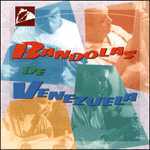

Dorian Discovery
DIS-80114
DE
VENEZUELA
Javier Sosa - Central Bandola
Gerson García - Llanera Bandola
Ricardo Sandoval - Oriental Bandola
Asdrubal (Cheo) Hurtado - Guayanese Bandola
 The origins of the "bandolas", according to some studies, seem to date back to the Persian Empire, travelling from there to the middle east, and penetrating Andalucía with the "moro" (Moorish) invasions. It was widely known as the "laud" for three centuries, and arrived in the Americas with the first conquerors. It is here that the process of transformation began, until the instrument was adapted to the actual spiritual characteristics of four regional cultures in our "Tierra de Gracia", the "Ilanero" (plains), the "oriental" (eastern), the "central" and the "guayanese", (each of these terms refers to a different geographical location in the Venezuelan territories).
The origins of the "bandolas", according to some studies, seem to date back to the Persian Empire, travelling from there to the middle east, and penetrating Andalucía with the "moro" (Moorish) invasions. It was widely known as the "laud" for three centuries, and arrived in the Americas with the first conquerors. It is here that the process of transformation began, until the instrument was adapted to the actual spiritual characteristics of four regional cultures in our "Tierra de Gracia", the "Ilanero" (plains), the "oriental" (eastern), the "central" and the "guayanese", (each of these terms refers to a different geographical location in the Venezuelan territories).. . . . - Roberto Todd
|
[1] PAJARILLO REVUELTO (Folklore, Adaptación Gerson García) [2] ZUMBA QUE ZUMBAO (Folklore, Adaptación Gerson García) [3] QUIR' PA SEIS (Folklore, Adaptación Gerson García) [4] SEIS NUMERAO (Folklore, Adaptación Gerson García) [5] AIRES DE MOCHIMA (Daniel Mayz) [6] EL CRUZAO (Ricardo Sandoval) [7] QUEBRADA SECA (Cruz Quinal) [8] EL PARRANDERO (Ramón Calzadilla) [9] BAJO SECO (Juan Esteban García) [10] EL HIJO DE LA CUBANERA (Juan Esteban García) [11] PUNTA APAMATE (Juan Esteban García) [12] PADRE NUESTRO (Juan Esteban García) [13] GUACHASEIS (Folklore, Adaptación Asdrúbal Hurtado) [14] EL PRISIONERO (Ramón Hurtado, Adaptación Asdrúbal Hurtado) [15] LOS BEJUCOS (Folklore, Adaptación Asdrúbal Hurtado) [16] LA JOSA (Folklore, Adaptación Asdrúbal Hurtado) |
Dorian Recordings & Dorian Discovery
are distributed in Australia by Rockian Trading